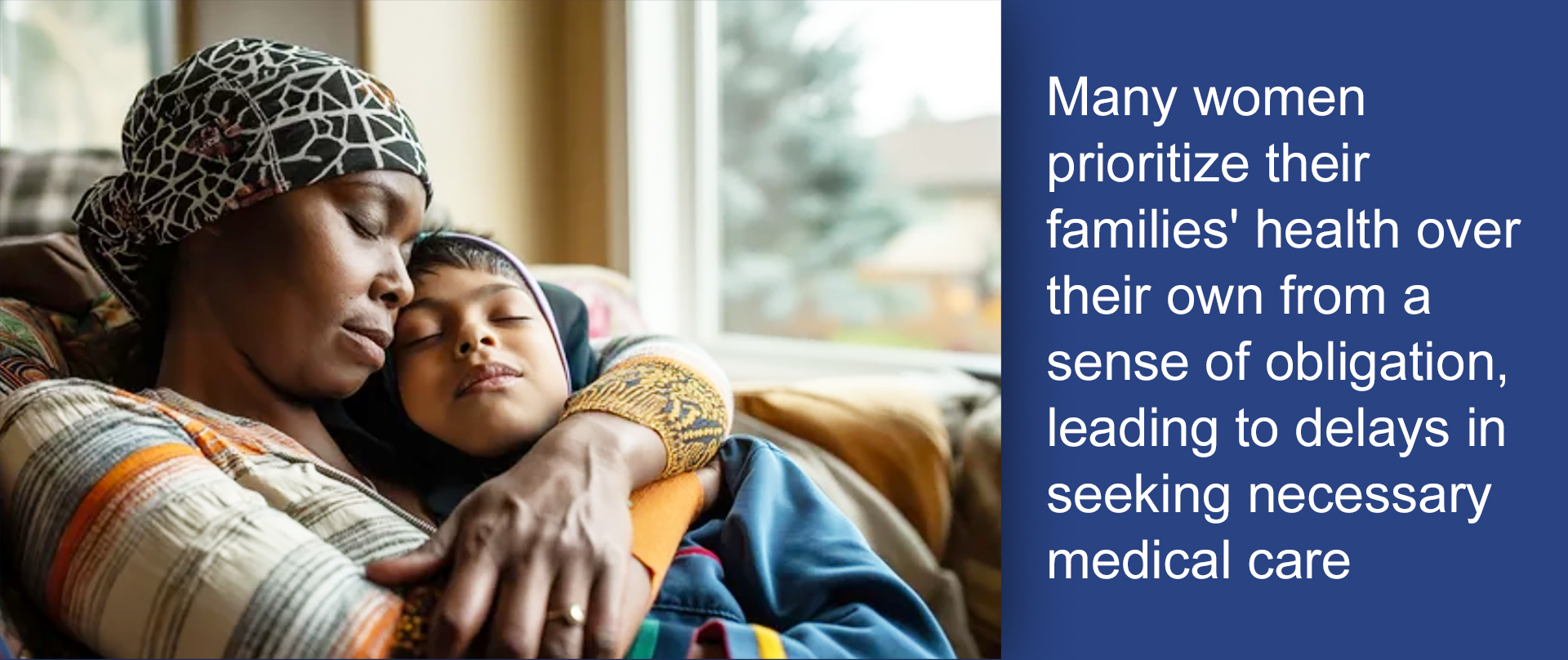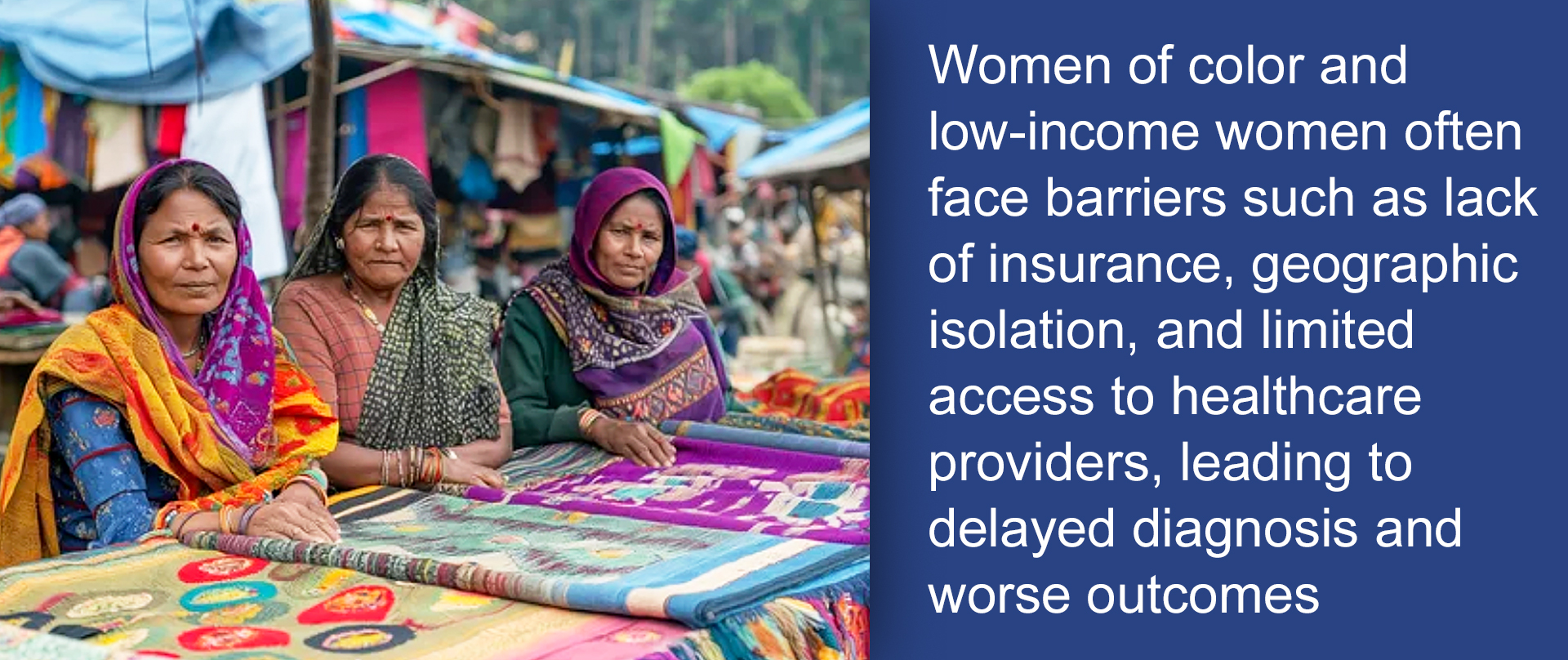The Ripple Effect Of Investing In Women’s Cancer Care: Empowering Economies, Families And Society

Maria Verghese, a 48-year-old mother of two from a small rural town in Michigan, was the backbone of her family – managing the household, taking care of her aging parents, and working part-time at a local grocery store.
She knew about breast cancer screenings but always found reasons to put them off.
Financial concerns played a big role; with her family struggling to make ends meet, Maria couldn’t justify spending money on what she believed was a “non-urgent” procedure. On top of that, she feared the pain and the possibility of discovering something bad. After all, she felt healthy and hadn’t noticed any symptoms.
Two years later, Maria felt a lump in her breast. By the time she sought medical advice, the cancer had already progressed to stage III. Treatment was aggressive—chemotherapy, surgery, and radiation—but the diagnosis came too late for her to avoid the harsh toll it would take on her body, family, and finances.
Maria had to step back from work entirely, and her husband took time off to care for her, causing their household income to plummet. Her children, previously focused on their education, found themselves taking on additional responsibilities at home.
The emotional toll was immense. Maria, once the nurturer, now needed constant care herself. Her children grappled with anxiety and worry about their mother’s health, while her parents, reliant on her support, suffered as well.
Cancer didn’t just attack Maria’s body; it fractured the stability of her entire family.
Had Maria gone for a mammogram at age 45, doctors could have caught the cancer at an earlier, more treatable stage. If she had been informed and financially supported to prioritize screening, the outcome for Maria—and her family—could have been entirely different…
• • • • • • •
For millennia, societal and cultural expectations have designated women as default caregivers and unacknowledged advocates for their family’s health and well-being. Despite centuries of progress, advances in gender equality and workforce participation, this role has remained largely unchanged.
In fact, as primary caregivers and decision-makers, women shoulder 80% of their family’s healthcare responsibilities, including not only children, but spouses, aging parents and extended relatives as well.
But this default leadership role doesn’t come without cost.
When faced with health crises—particularly those related to cancer prevention and screenings—women’s needs have often been marginalized, resulting in a critical oversight that delays essential care, exacerbates health disparities and jeopardizes their well-being.
Let’s examine the current landscape of cancer in women by focusing on the types of malignancies that most impact them:
Breast Cancer remains the most frequently diagnosed cancer among women worldwide. It is estimated that in 2024, approximately 30% of all new female cancer diagnoses will be breast cancer.
One in 25 women will develop colorectal cancer (CRC) in their lifetime, according to the American Cancer Society (ACS), and so far we’re seeing that while incidence rates of this largely treatable disease have decreased slightly, mortality rates have risen due to late-stage diagnoses and insufficient screening.
Lung cancer is a significant health risk for women globally. Despite decreasing lung cancer rates overall, the decline is happening more slowly in women (1.1% per year) compared to men (2.6% per year). Lung adenocarcinoma is the most common type found in women, with them being almost twice as likely as men to develop lung cancer without a smoking history.
Endometrial cancer (also known as uterine cancer) remains the most prevalent gynecological manifestation of the disease among women, particularly in high-income countries. (Approximately 66,200 new cases of uterine cancer, the majority of which are endometrial, were diagnosed in the US in 2023.) Its incidence has been steadily rising in recent years, and according to the latest data from the American Cancer Society, there has been a concerning two per cent annual increase in mortality rates for endometrial cancer, with black women facing nearly double the mortality rate of white women, highlighting widening racial disparities in outcomes.
In the United States, it is estimated that around 13,820 new cases of invasive cervical cancer will be diagnosed in 2024, and about 4,360 women will die from the disease, according to the National Cancer Institute. Globally, cervical cancer is more prevalent, especially in low and middle-income countries (LMICs) due to limited access to preventive measures like the HPV vaccine (the HPV infection remains the leading cause of cervical cancer, responsible for about 90% of cases) and regular Pap tests.
Ovarian cancer ranks as the fifth leading cause of cancer deaths among women, accounting for more fatalities than any other cancers of the female reproductive system.
Tagged with the reputation of a “silent killer” (because symptoms often go unnoticed until advanced stages), the survival rate varies significantly based on the stage at diagnosis. When detected early (at stage I), the 5-year relative survival rate can be as high as 93%, but only about 20% of ovarian cancers are detected at this early stage. The overall 5-year relative survival rate across all stages is around 49% .
As of 2024, non-melanoma skin cancers (NMSCs), which include basal cell carcinoma (BCC) and squamous cell carcinoma (SCC), continue to be the most common cancers in women, although precise statistics for women alone can be difficult to isolate from general population data.
Over 3.3 million people are diagnosed annually with basal and squamous cell carcinomas in the United States, but these cancers are often underreported because they are usually non-lethal and excluded from major cancer registries like SEER (Surveillance, Epidemiology, and End Results).
“Even in the face of such overwhelming evidence of cancer prevalence and poor outcomes, women are often less likely to seek screening and treatment due to various interconnected factors including the lack of information on risk factors or poor health literacy, financial barriers, socio-cultural beliefs, and other health related social needs,” says Tara Shah, co-founder of Binaytara Foundation, a non-profit organization in Bellevue, WA, that is dedicated to reducing cancer disparities, making evidence-based cancer care accessible, and improving patient outcomes worldwide. “Many women prioritize their families’ health over their own from a sense of obligation, leading to delays in seeking necessary medical care.”

The implications of these delays are significant, not only for the women affected but also for their families. When women, as primary caregivers, do not receive timely diagnosis and treatment themselves, it can lead to deteriorating health, which ultimately impacts their ability to care for others.
This creates a ripple effect that can disrupt family dynamics, increase stress among family members, and potentially result in greater health issues for other family members.
Investing in women’s cancer prevention and care, therefore, is not just a health issue—it is a societal imperative. By prioritizing the health of women, we pave the way for healthier families and communities. The journey to effective cancer prevention begins with education and awareness, empowering women to take charge of their health.
In this blog, we will explore the critical importance of supporting women’s cancer prevention initiatives, not only for their benefit but for the greater good of society as a whole.
Gender Gap In Cancer Prevention And Treatment
Despite women playing a critical role in healthcare decision-making, the gender gap in cancer management remains a stark reality. Women often face significant challenges in accessing timely and equitable care, particularly when it comes to cancer, and the prevention, screening, and treatment landscape often reflects systemic gender disparities that put women at a disadvantage.
For instance, while breast cancer is highly treatable with early detection, significant gaps in access to screenings like mammograms exist, especially in underserved communities. Women of color and low-income women often face barriers such as lack of insurance, geographic isolation, and limited access to healthcare providers, leading to delayed diagnosis and worse outcomes.
This gap is not limited to breast cancer. Cervical cancer, largely preventable through HPV vaccinations and regular Pap tests, remains one of the leading causes of cancer deaths among women in LMICs. Despite the availability of preventive measures, millions of women worldwide still lack access to these life-saving tools, aggravating health disparities between high-income and low-income populations.
A 2023 study published in The Lancet further underscores the gender disparity in cancer treatment. It found that women are more likely to experience delays in receiving care compared to men, resulting in later-stage diagnoses. This is particularly evident in cancers like lung cancer, where although women are increasingly at risk, awareness and early screening campaigns lag behind those for men.
Addressing this gender gap is not just about providing access to care but about prioritizing the unique healthcare needs of women. A more equitable approach to cancer prevention and treatment must involve targeted outreach, improved healthcare policies, and a concerted effort to dismantle the social and economic barriers that disproportionately affect women.
Ultimately, closing the gender gap in cancer care will save countless lives, reduce the emotional and financial toll on families, and foster a more resilient healthcare system that works for everyone.
The Economic And Social Benefits Of Investing In Women’s Health
Investing in women’s health—particularly in the early detection and prevention of cancer—is not only a moral imperative but also an economic strategy that has far-reaching benefits for families, communities, and society as a whole.
• Lowering Healthcare Costs Through Early Detection: Early cancer detection can drastically reduce treatment costs. According to the American Cancer Society, treatment for early-stage breast cancer is less invasive, less costly, and has significantly better survival rates than treatment for later-stage cancer.
For instance, stage I breast cancer treatment costs average around $15,000 per patient, compared to over $180,000 for late-stage treatment. This stark difference highlights the economic value of investing in regular screenings and preventive measures.
When cancer is caught early, not only are treatment costs lower, but patients often require fewer resources from the healthcare system overall. Preventive care, like mammograms and Pap smears, is far more cost-effective than managing advanced-stage cancer, which requires prolonged hospital stays, expensive surgeries, chemotherapy, and additional support services.

• Economic and Workforce Impact: Women play a critical role in both the family and the workforce. According to a study by the World Bank, women make up approximately 40% of the global labor force and provide an estimated $3 trillion in unpaid caregiving services each year.
When a woman falls ill with cancer, it often results in a domino effect that can disrupt entire families and communities. If the woman is a primary caregiver or breadwinner, the care she provides to children, elderly relatives, and other dependents is often lost, increasing the burden on family members and social services.
The Centers for Disease Control and Prevention (CDC) estimates that chronic diseases like cancer cost the US economy more than $1 trillion annually in lost productivity due to premature deaths, reduced labor supply, and increased absenteeism. By focusing on prevention and early treatment, we can mitigate these losses and sustain the economic contributions of women across all sectors.
• Strengthening Communities: Healthy women build stronger communities. When women have access to cancer prevention, screening, and treatment services, they are more likely to thrive both personally and professionally.
This is particularly important in low-income communities, where women are often the pillars of family support and her health is directly linked to reductions in poverty rates, increased educational opportunities for children, and enhanced overall community well-being for future generations.
Call To Action: What Can Be Done
The fight against women’s cancers requires more than individual awareness—it demands collective action at every level, from individuals to organizations and governments. Here’s how we can all contribute to making a significant difference:
• Empower Women Through Knowledge: Studies after studies have shown that one of the major reasons women do not get screened is because they lack information or do not know/understand the risk factors. When women understand the potential risks associated with different types of cancer, they are empowered to make informed decisions about their health.
Education campaigns can help raise awareness of the importance of regular check-ups, lifestyle changes, and recognizing symptoms early on, potentially saving lives by promoting timely interventions.
• Support Cancer Research: Funding cancer research is critical for developing new and effective treatments. Breakthroughs in immunotherapy, genetic testing, and personalized medicine have already saved countless lives, but more work remains to be done.
By donating to reputable cancer research organizations or advocating for increased governmental research funding, we can help accelerate the discovery of life-saving treatments.
• Expand Access to Affordable Screenings: Governments and healthcare systems must prioritize affordable and accessible cancer screenings, especially for underserved populations. Cost should not be a barrier to preventive care.
• Educate and Empower Women: Many women delay or skip cancer screenings due to misinformation or a lack of understanding. Initiatives that educate women about the importance of early detection and the safety of screenings can have a transformative impact.
Encouraging organizations and local communities to host awareness campaigns, workshops, and provide resources will help empower women to take charge of their own health. Community education programs have proven to be effective; for example, public health campaigns led to a 25% increase in mammogram screening rates among targeted groups in certain states.
• Advocate for Policy Change: Policies that support women’s health, such as mandated insurance coverage for cancer screenings, expanded funding for cancer research, and workplace protections for women undergoing cancer treatment, are essential.
Individuals can advocate for these policies by contacting their legislators, supporting pro-health candidates, and participating in public health dialogues. Grassroots advocacy can push governments to prioritize cancer prevention and women’s health in a way that makes a lasting societal impact.
Conclusion: Get Involved And Make A Difference
You can make a personal impact today.
Whether it’s by volunteering with cancer support organizations, donating to cancer research foundations, or simply starting a conversation with your family and friends about the importance of regular screenings, every action matters. Encouraging others to take their health seriously is the first step in breaking down barriers to cancer prevention and changing the trajectory for future generations.
By investing in women’s health, we’re not just saving lives—we’re safeguarding the health of entire families, communities, and economies.
“It’s time to act—not just as individuals but as a global community. Collective action is our most powerful tool,” says Tara Shah.
Together, we can bridge the gap.
• LIKE THIS ARTICLE?
———————————
Share it with your friends and family to raise awareness about the disparities in cancer screening, prevention, and care for women!

The Rose International Fund for Children Awards $165,400 to Binaytara Foundation to Create Life-Saving Ostomy Program in Janakpur, Nepal

Dr. Raquel Sanchez Presents on Global Health Leadership



